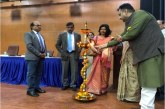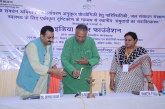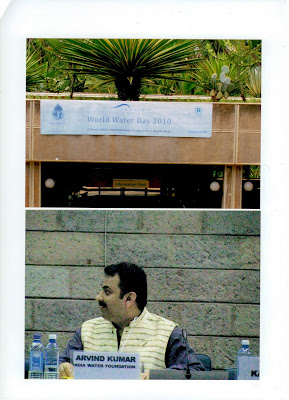(Part of Opening Remarks by Dr Arvind Kumar President India Water Foundation, in National Seminar on “Increasing Water Efficiency in Agriculture Sector” on 19th February 2010 Gulmohar Hall, India Habitat Centre, New Delhi in Inaugural Session Mr. Gokul Patnaik CII, Mr. Anil B Jain MD Jain Irrigation System Ltd., Guest of honor Mr. G C Pati Additional Secretary Government of India, Chief Guest Mr. A K Bajaj Chairman Central water Commission and Mr. S Sen Principal Adviser CII. Other distinguish Mr. R C Jhamtani Ex Member Planning Commission, Dr H P Singh Dy. DG ICAR, Mr. T B S Rajput Director IARI Delhi and Mr. Surendra Gupta CMD Dulichand Narendra Kumar Pvt. Ltd. Rice Exporter Etc. Organized by Confederation of Indian Industry)
Honorable members of the panel of experts, ladies and gentlemen,
It is pleasure for me to chair this session on Agriculture and Water – Issues and Challenges for which I am grateful to the CII. If agriculture is the backbone of Indian economy, then water is the backbone of agriculture. Viewed in a broad spectrum, Agriculture is a vital sector in India with about 60% of the population engaged in agricultural vocations and contributing to about 30% of the GDP. It consumes about 80% of water used in the country and 76% of the net irrigated area in the country is from ground water sources. Better water management in agriculture will go a long way in improving our crop productivity and thereby total output to feed the masses, not only of India but also of other parts of the world. This would also make more water available for other crucial needs like the domestic and industrial sectors.
Increasing and competing demands for freshwater — for drinking, agricultural, urban and industrial uses — are placing increased pressure on global water resources. Irrigation of crops is the main user of freshwater resources in most developing countries and in Australia. Growing populations and associated urbanization are, however, accelerating water consumption. ACIAR is supporting research on more efficient irrigation in developing countries, to relieve some of this pressure.
The use of water for agricultural irrigation dates back to the ancient civilizations of Egypt, Mesopotamia and China. These ancient civilizations organized their cultures around irrigation resulting in few competing demands for water. Today rapid population growth has increased urbanization, particularly in developing countries. More mouths mean more water for drinking; greater population densities require more water for sanitation; while industrialization has raised the thirst for water from manufacturing and commercial sectors. Environmental flows to replenish depleted water resources are being utilized in a number of developed countries, and in some developing countries.
The resulting total of these demands is far greater pressure on water resources and water users.
According to a report released by US-based space agency NASA’s Goddard Space Flight Center, groundwater beneath northern India has been vanishing at a rate of a foot per year during the last decade. In total 109 cubic kilometers (26 cubic miles) has been lost in six years time. It is perceived as a disaster in the making. According to Matt Rodell, lead author of this study, which appeared in Nature: “If measures are not soon taken to ensure sustainable groundwater usage, consequences for the 114 million residents of the region may include a collapse of agricultural output, severe shortages of potable water, conflict and suffering.”
The researchers found that the reason for the declining water was due to human consumption with irrigation as the primary cause. The loss of groundwater is particularly troublesome because replenishment of the water can take months or years and is dependent on local conditions. Unlike rivers and lakes, sources of groundwater do not respond directly to precipitation.
According to Jay Famigliett of UCI Earth system: “Groundwater mining – that is when withdrawals exceed replenishment rates – is a rapidly growing problem in many of the world’s large aquifers. Since groundwater provides nearly 80 percent of the water required for irrigated agriculture, diminishing groundwater reserves pose a serious threat to global food security.”
Growing demand for diverse uses of water because of rapid industrialization, urbanization and population growth is causing acute pressure on development of water resources. This brings into focus the issue of user-cost of water. Increased and indiscriminate use of commercial fertilizers and pesticides, generation of new and toxic wastes by industries, municipal and domestic sewages, are severely polluting our water resources. Concern for water quality is, therefore, going to be very critical in water resource development and management. Prevention of environmental degradation should occupy a central place in the water resource development programmes. Adopting sustainable agricultural practices focusing more on organic inputs like bio-ferilizers, bio-pesticides, green leaves etc. is likely to help the agriculture sector in the long run.
Thus, it is vital that water is used more judiciously for producing crops using improved methods of cultivation. A well-designed drip system of irrigation proves to be very efficient water saving device without decreasing yields. It also improves the quality of produce fetching better price in the market. It is estimated that this system of irrigation is likely to save about 40% of water compared to flood irrigation (provide link). Sprinkler irrigation is another popular system of irrigation suitable for many crops.
Paddy and Sugarcane are the two major high water consuming crops. Effective water management in such crops would go a long way in increasing output per unit of water. Now time has come for concentrating on productivity of water more seriously than productivity of land. It is estimated that about 5000 litres of water is used to produce a kilogram of rice! The SRI method of paddy cultivation is the latest technology for saving about 50% water and increase yield too! This system needs to be widely propagated with expert advice on cultivation methods.
Dry land agriculture or rain-fed agriculture is also an important sector within agriculture, which is mainly dependant on rainfall for producing crops. Significant quantity of Jowar (Sorghum), Bajra (Pearl millet), Ragi (Finger millet) and other minor millets, which are the staple food of the poor, are grown depending on rainfall. Proper agronomic practices and in-situ moisture conservation is vital to harvest a good crop in such conditions. The watershed approach is ideal in these rain-fed areas which aims at treating degraded lands with the help of low cost, locally accessible technologies involving the user community.
Watershed development projects are designed to harmonize the use of water, soil, forest and pasture lands in ways that conserve these resources while increasing agricultural productivity, both by conserving moisture in the ground and increasing irrigation through tank and aquifer based water harvesting. Equitable harnessing of benefit among upper-reach and lower-reach community is a vital issue to be sorted out through detailed discussion with the user communities.
Water resource management is critically significant in India owing to the growing demand for food and because the incomes and employment of 60-70 per cent of Indians depend on agriculture. Irrigation is a key feature of India’s agricultural strategy, but it is not being used to its potential. In fact, the excessive and indiscriminate use of water has often resulted in substantial harm to the soil and reduced productivity. Unfortunately, water resource management in India is suffering. Surface water management requires heavy investment including meeting technical needs and environmental concerns. Groundwater management must reduce excessive pumping and address inadequate recharge of the water table. There are simple, well-known technical and economic solutions to the problems, but institutional arrangements are complex which need support. There is an urgent need to develop better and more socially acceptable institutional arrangements.
A cursory glance of the Planning documents reveals an optimistic view of the water vis-à-vis agriculture which can be enumerated as follow:
· A sustained and substantial expansion of irrigated areas and cropping intensity can be achieved;
· A significant improvement in irrigation efficiency by more intensive recycling of seepage and regeneration of water from canals and reducing wasteful use;
· They argue that total water requirements will approach the limits of utilizable supplies in the cause of next two decades and the potential may well be exhausted by mid-century;
· Some others are of the view that supplies will be inadequate to meet requirements that India will have to import sizeable amounts of food and that scarcity will lead to an intensification of conflicts over water.
However, the key question is that “How much water will be needed in the coming decades and to what extent and in what ways they can be met?” This situation leaves us for having a rationale debate. Broadly speaking, assessment of the future water scenario, particularly for agriculture sector depends critically on the following points:
i. The technically feasible and economically viable augmentation of the quantum of surface and groundwater use;
ii. The quantum of water needed to meet the requirement of consumptive use for crops and for various nonagricultural uses;
iii. The ratio of consumptive use to gross utilization in different uses (which is one measure of water use efficiency), the scope and prospects of increasing the ratio;
iv. Increasing the productivity per unit of consumptive use in agriculture which accounts for the bulk of present and future demand for water.
I do hope that the elite experts participating in this session will dwell on these and other related issues and we will be benefited from their experience and expertise.
Thank you very much.



